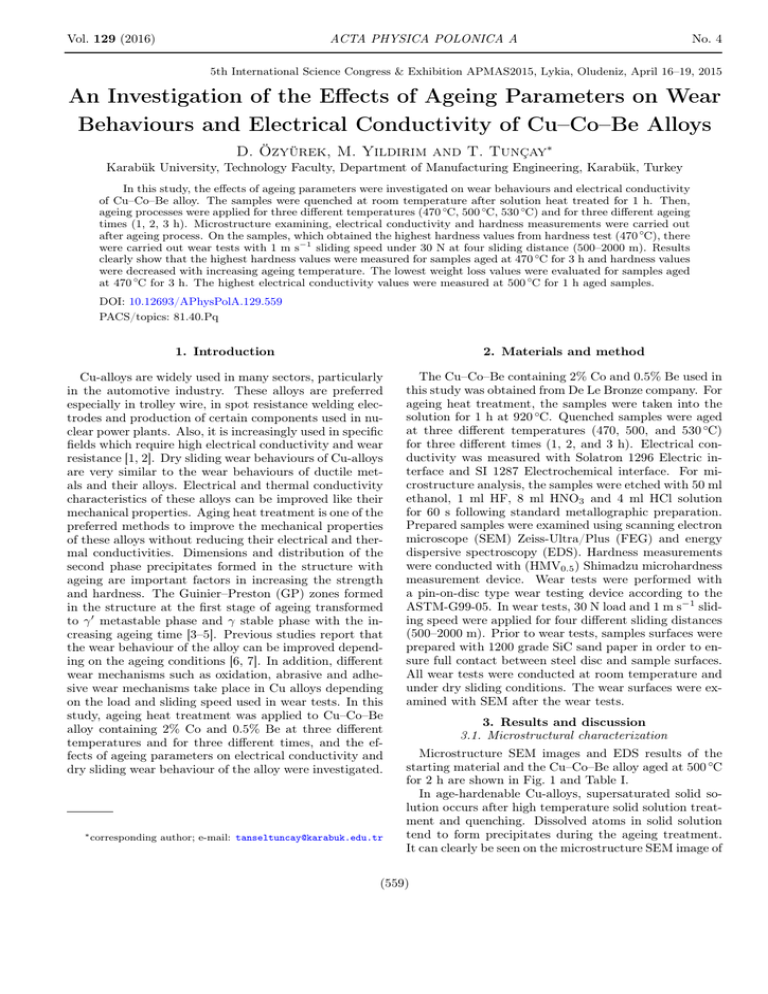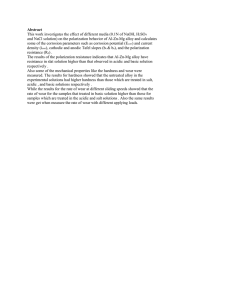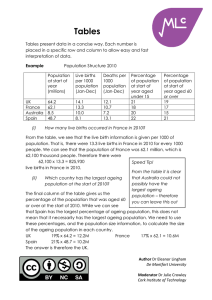Full Text PDF
advertisement

Vol. 129 (2016) ACTA PHYSICA POLONICA A No. 4 5th International Science Congress & Exhibition APMAS2015, Lykia, Oludeniz, April 16–19, 2015 An Investigation of the Effects of Ageing Parameters on Wear Behaviours and Electrical Conductivity of Cu–Co–Be Alloys D. Özyürek, M. Yıldırım and T. Tunçay∗ Karabük University, Technology Faculty, Department of Manufacturing Engineering, Karabük, Turkey In this study, the effects of ageing parameters were investigated on wear behaviours and electrical conductivity of Cu–Co–Be alloy. The samples were quenched at room temperature after solution heat treated for 1 h. Then, ageing processes were applied for three different temperatures (470 ◦C, 500 ◦C, 530 ◦C) and for three different ageing times (1, 2, 3 h). Microstructure examining, electrical conductivity and hardness measurements were carried out after ageing process. On the samples, which obtained the highest hardness values from hardness test (470 ◦C), there were carried out wear tests with 1 m s−1 sliding speed under 30 N at four sliding distance (500–2000 m). Results clearly show that the highest hardness values were measured for samples aged at 470 ◦C for 3 h and hardness values were decreased with increasing ageing temperature. The lowest weight loss values were evaluated for samples aged at 470 ◦C for 3 h. The highest electrical conductivity values were measured at 500 ◦C for 1 h aged samples. DOI: 10.12693/APhysPolA.129.559 PACS/topics: 81.40.Pq 1. Introduction 2. Materials and method Cu-alloys are widely used in many sectors, particularly in the automotive industry. These alloys are preferred especially in trolley wire, in spot resistance welding electrodes and production of certain components used in nuclear power plants. Also, it is increasingly used in specific fields which require high electrical conductivity and wear resistance [1, 2]. Dry sliding wear behaviours of Cu-alloys are very similar to the wear behaviours of ductile metals and their alloys. Electrical and thermal conductivity characteristics of these alloys can be improved like their mechanical properties. Aging heat treatment is one of the preferred methods to improve the mechanical properties of these alloys without reducing their electrical and thermal conductivities. Dimensions and distribution of the second phase precipitates formed in the structure with ageing are important factors in increasing the strength and hardness. The Guinier–Preston (GP) zones formed in the structure at the first stage of ageing transformed to γ 0 metastable phase and γ stable phase with the increasing ageing time [3–5]. Previous studies report that the wear behaviour of the alloy can be improved depending on the ageing conditions [6, 7]. In addition, different wear mechanisms such as oxidation, abrasive and adhesive wear mechanisms take place in Cu alloys depending on the load and sliding speed used in wear tests. In this study, ageing heat treatment was applied to Cu–Co–Be alloy containing 2% Co and 0.5% Be at three different temperatures and for three different times, and the effects of ageing parameters on electrical conductivity and dry sliding wear behaviour of the alloy were investigated. The Cu–Co–Be containing 2% Co and 0.5% Be used in this study was obtained from De Le Bronze company. For ageing heat treatment, the samples were taken into the solution for 1 h at 920 ◦C. Quenched samples were aged at three different temperatures (470, 500, and 530 ◦C) for three different times (1, 2, and 3 h). Electrical conductivity was measured with Solatron 1296 Electric interface and SI 1287 Electrochemical interface. For microstructure analysis, the samples were etched with 50 ml ethanol, 1 ml HF, 8 ml HNO3 and 4 ml HCl solution for 60 s following standard metallographic preparation. Prepared samples were examined using scanning electron microscope (SEM) Zeiss-Ultra/Plus (FEG) and energy dispersive spectroscopy (EDS). Hardness measurements were conducted with (HMV0.5 ) Shimadzu microhardness measurement device. Wear tests were performed with a pin-on-disc type wear testing device according to the ASTM-G99-05. In wear tests, 30 N load and 1 m s−1 sliding speed were applied for four different sliding distances (500–2000 m). Prior to wear tests, samples surfaces were prepared with 1200 grade SiC sand paper in order to ensure full contact between steel disc and sample surfaces. All wear tests were conducted at room temperature and under dry sliding conditions. The wear surfaces were examined with SEM after the wear tests. ∗ corresponding author; e-mail: tanseltuncay@karabuk.edu.tr 3. Results and discussion 3.1. Microstructural characterization Microstructure SEM images and EDS results of the starting material and the Cu–Co–Be alloy aged at 500 ◦C for 2 h are shown in Fig. 1 and Table I. In age-hardenable Cu-alloys, supersaturated solid solution occurs after high temperature solid solution treatment and quenching. Dissolved atoms in solid solution tend to form precipitates during the ageing treatment. It can clearly be seen on the microstructure SEM image of (559) 560 D. Özyürek, M. Yıldırım, T. Tunçay Fig. 1. Micro structure SEM images of the starting material (a) and the Cu–Co–Be alloy aged at 500 ◦C for 2 h (b). TABLE I The Cu–Co–Be alloy aged at 500 ◦C for 2h (Fig 1b) — EDS results. Location 1 2 3 4 Elements [wt.%] Be Co Cu 1.39 29.22 69.39 1.10 0.83 98.06 0.89 1.20 97.91 0.99 1.31 97.70 aged alloy that second phase precipitates formed during the ageing treatment (Fig. 1b). It is understood from the EDS analysis results given in Table I that these precipitates are Co- and Be-rich. According to Yağmur et al. [5], metastable γ 0 precipitates grow and transform to stable γ precipitates as the duration of the ageing treatment increases. It is also observed that second phase precipitates are distributed homogeneously in the structure of alloy. 3.2. Hardness and electrical conductivity Hardness and electrical conductivity values (% IACS) of Cu–Co–Be alloy before and after the ageing heat treatment at different temperatures and durations are given in Table II. TABLE II Hardness and % electrical conductivity values of the samples aged at different temperatures for different durations. Ageing temperature ◦ C 470 500 530 Aging time [h] Un-aged 1 2 3 1 2 3 1 2 3 Electrical conductivity [% IACS] 77.95596 84.63403 86.39965 86.14106 90.02204 75.22076 83.91571 80.26296 76.89184 88.43324 Hardness [HMV] 106 234.6 250 259.2 227.4 220.6 210 218 218.8 203 Table II shows that the highest hardness value was measured for the samples aged at 470 ◦C for 3 h, and the hardness decreases by the increasing ageing time and temperature (500 ◦C and 530 ◦C). The effects on hardness and strength of second phase precipitates formed in the structure by ageing are usually determined by the relationship between precipitates and dislocations. This relationship is explained with a mechanism known as the Orowan mechanism 0.81Gb ln(2r/b) τρ = , (1) 1/2 λ − 2r 2π(1 − v) where G is the sliding module of the copper matrix, b is the burger vector, r is the mean radius of the precipitates and λ is the dislocation cutting distance [3]. Table II shows the electrical conductivity variations (IACS %) of the Cu–Co–Be alloy depending on ageing treatment temperature and time. The highest conductivity values were obtained for the samples aged at 500 ◦C for 3 h. When the IACS % value obtained is correlated with the electrical conductivity value of the sample with the highest hardness value (aged at 470 ◦C for 3 h), it is understood that the conductivity is similar. Comparing the hardness and electrical conductivity values of the samples with the highest hardness and electrical conductivity values with un-aged samples, it can easily be concluded that the ageing process is a must for these alloys. It is understood that the Co- and Be-rich precipitates were effective on the increasing IACS % value. Over-ageing decreases the hardness and increases the electrical conductivity of alloy. Aging treatment causes distortion at the lattice of the alloy. Although the lattice distortion of the alloy usually aggravates electrical conductivity, it is understood that the electrical conductivity increased with the increasing Co and Be content in the second phase precipitates. The electrical conductivity increases as a result of these two mechanisms that take place at the same time and compensate each other. The electrical conductivity results obtained are supported by an earlier study [8]. 3.3. Wear tests Since the samples aged at 470 ◦C had the highest hardness values, the wear tests were performed on these Cu– Co–Be alloys aged at 470 ◦C for three different times. The weight loss of the Cu–Co–Be alloy aged at 470 ◦C for three different times are given in Fig. 2. As can be seen in Fig. 2, the samples that were aged at 470 ◦C for 1 h had the highest weight loss value after the wear tests under 30 N load with 2000 m sliding distance and the samples aged at the same temperature for 3 h had the lowest value. The obtained results clearly support the hardness results given in Table II. It is understood that the samples with a high hardness value had a low weight loss and the samples with a low hardness value had a high weight loss. These results are also in agreement with some previous studies [6, 9]. According to these results, the weight loss decreases by the increasing treatment time. This is because the size of the second phase precipitates formed in the structure increases by An Investigation of the Effects of Ageing Parameters. . . 561 the treatment time which makes dislocation movement more difficult in the wear tests. SEM images of the worn surfaces after the wear tests are given in Fig. 3. Figure 3 shows the SEM images of heavy plastic deformation on the worn surfaces of all samples which was a function of the ageing time and sliding system. It can also be seen that particles, detached from the surface during the wear tests due to tribosystem, smear to the sample surface with adhesion effect. It was also observed that local debris occurred on the sample surfaces during the wear tests. 4. Conclusion Fig. 2. The weight loss of the Cu–Co–Be alloy aged at 470 ◦C for three different times. In this study, the effects of ageing treatment parameters on electrical conductivity and wear behaviour of Cu–Co–Be alloys were investigated. Following conclusions can be made from the study: • Stable γ precipitates were successfully produced using ageing treatment in the structures of Cu–Co–Be alloys that were aged at three different temperatures for three different times. • According to hardness measurement results, the samples that were aged at 470 ◦C for 3 h have the highest hardness value. • According to electrical conductivity measurement results, the samples that were aged at 500 ◦C for 1 h has the highest electrical conductivity value. • While the samples that were aged at 470 ◦C for 3 h had the lowest weight loss after the wear tests, the samples that were aged at the same temperature for 1 h had the highest weight loss. References [1] H. Fuxiang, L. Chao, M. Jusheng, N. Honglong, G. Zhiting, L. Chao, G. Shumei, Y. Xuetao, W. Tao, L. Hong, L. Huafen, Scr. Mater. 48, 97 (2003). [2] Q. Liu, X. Zhang, Zhang, Y. Ge, J. Wang, J.Z. Cui, Metall. Trans. A 37A, 3233 (2006). [3] X. Guoliang, W. Qiangsong, M. Xujun, X. Baiqing, P. Lijun, Mater. Sci. Eng. 558, 326 (2012). [4] P. Scardi, M. Leoni, G. Straffelini, G. De Giudici, Acta Mater. 55, 2531 (2007). [5] L. Yağmur, O. Duygulu, B. Aydemir, Mater. Sci. Eng. A 528, 4147 (2011). [6] H.B. Yıldız, M. Yaşar, Metallofiz. Noveishie Tekhnol. 29, 1659 (2007). [7] D. Özyürek, İ. Çiftci, T. Tuncay, Mater. Test. 55, 468 (2013). Fig. 3. Worn surface SEM images of the Cu–Co–Be alloy aged at 470 ◦C for three different times. [8] İ. Sağlam, D. Özyürek, K. Çetinkaya, Bull. Mater. Sci. 34, 1465 (2011). [9] Y. Altunpak, Sci. Res. Essays 5, 2997 (2010).




